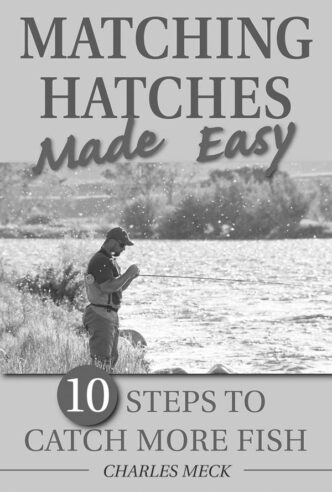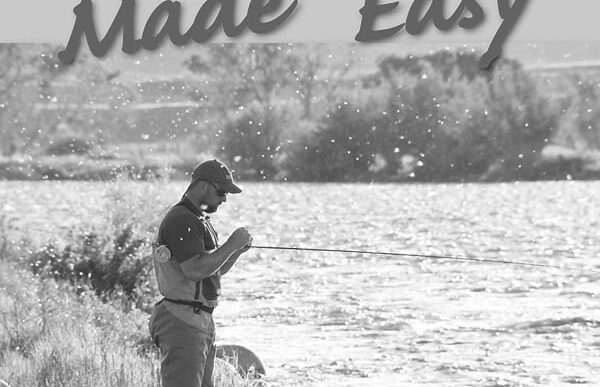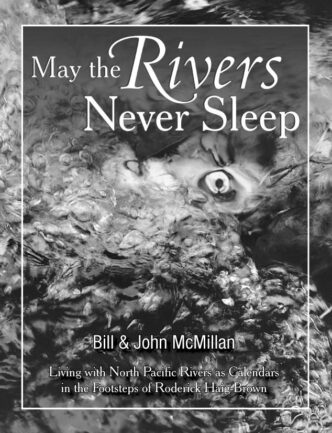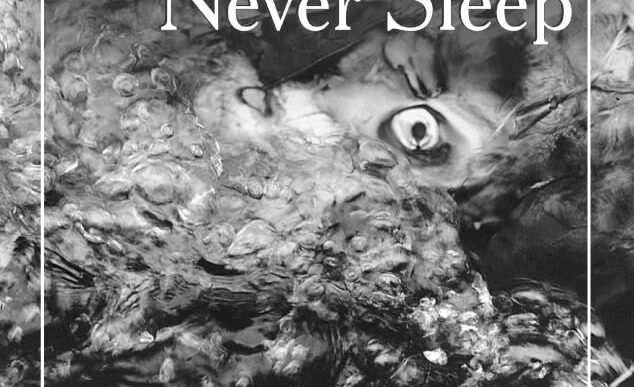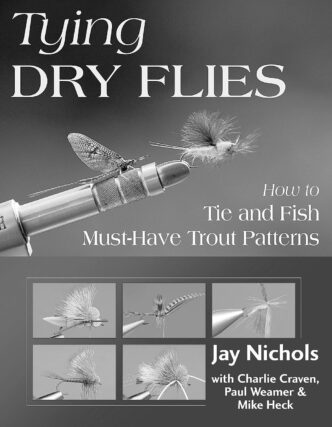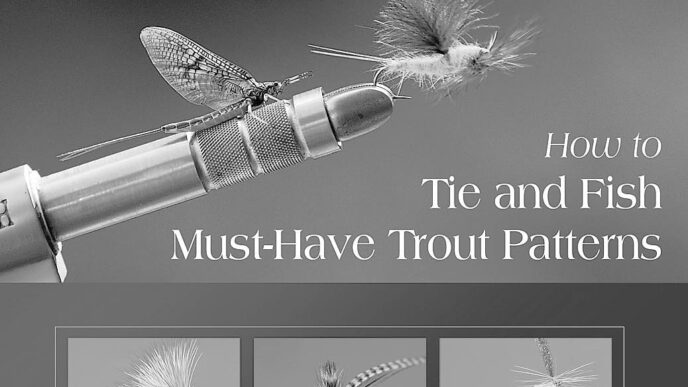Flies for Western Super Hatches
By Jim Schollmeyer and Ted Leeson. Published by Stackpole Books, 2011; $44.95 hardbound.
One of the interesting things about books is that the ways they get used often exceed the professed reasons why their authors write them. I don’t mean that they end up as doorstops or interior decoration, but that what readers find and value in a book isn’t always what was placed at the center of the text. Authors often find out, sometimes to their despair and sometimes to their delight, that they have written more than they actually thought they wrote — have accomplished more and different things than they thought they had intended.
The premise behind Flies for Western Super Hatches is that there are an awful lot of fly patterns out there these days and that as a result, fly fishers are faced with a problem: “given the wealth of options, which patterns are worth investing the time and effort, both on the water and at the vise?” Flies for Western Super Hatches offers anglers in the western United States “a reservoir from which anglers can choose a selection of flies tailored to the hatch profile of the specific waters they fish.” It’s not “some essential ‘Western fly box,’” but a collection of patterns, with step-by-step tying instructions and photos, that could just as well be titled Flies That Schollmeyer and Leeson Say Work.
Schollmeyer and Leeson have produced some of the most useful books on fly tying in the last decades, including the magisterial Fly Tier’s Benchside Reference and the innovative Benchside Introduction to Fly Tying, the authors appear regularly in the national angling press, and both fish more than it’s likely that you or I ever will, so whatever Schollmeyer and Leeson say works is certainly worth knowing. The “super hatches” that they cover are indeed the principal hatches of the American West. The authors, however, discuss not only what they call the “major hatches,” those that are “so widespread and abundant that virtually no angler can afford to venture astream without patterns to represent at least some of them,” but also “locally important hatches,” such as the Hexagenia limbata hatch, that may occur only in a few places, but when they do, oh boy. And by “hatch” they really mean “things that trout eat”: in addition to all the usual aquatic insects, they cover patterns for terrestrials, aquatic worms, fish eggs, baitfish and sculpins, leeches, scuds, and sow bugs.
That’s all well and good. Some of the flies that Schollmeyer and Leeson recommend are not new: paradun patterns, Clouser Minnows, and LaFontaine Deep Sparkle Pupas, for example. Patterns such as these are covered because they do in fact work and have continued to prove themselves. There are also some interesting patterns and tying techniques that I hadn’t encountered before: Bat-Wing Emergers, tied not with the wings of bats, but with a V wing made from the webby base of a hen hackle, innovative use of sturdy snowshoe rabbit in place of the fragile cul de canard for spinner wings and small paraduns, and a “parasol” emerger pattern that suspends a nymph just below the surface of a puff of polypropylene yarn on a stalk of mono. The step-by-step instructions for all these patterns, both familiar and new, are photographed and explained in Schollmeyer and Leeson’s exemplary style, which is the gold standard for such things.
What I value in the book, however, is something different from what they principally intended. For every insect hatch, and indeed, for every “hatch,” including leeches and sculpins, there is a photo of the underside of the bug or other critter to be imitated, as well as photos of its top and side. It’s one of the paradoxical truisms of fly fishing and fly tying that anglers and tyers look at flies from the top and side, whereas most of the time, fish see them more or less from the botttom, and for reasons of protective coloration, bottoms almost always are different shades and colors from sides and tops. Not just to be reminded of this, when tying flies to match a hatch, but to be given some sense of the shades and hues involved in what an item of trout food actually looks like from a fish’s point of view is what I find makes Flies for Western Super Hatches worthwhile. Schollmeyer and Leeson obviously intended these wonderful pictures as a sort of sauce for the main course here, but as every gourmand knows, sometimes the sauce makes the meal.
Bud Bynack
The Classic Wet Fly Box
By Mike Valla. Published by The Whitefish Press, 2012; $24.95 softbound.
The classic wet fly don’t get no respect these days. It’s an age of hatch matching, and of adrenaline junkies who seek the thrill of the top-water grab that comes with fishing dries, and of bobberheads who live for the coup counts of indicator nymphing. As angling historian and master fly tyer Mike Valla notes, the eclipse of the classic wet by dry flies has been proceeding apace for a century, since the days of Frederick Halford and Theodore Gordon. Nymphing has largely replaced swinging a “cast” of two or three wets, and why and when one would fish a particular classic pattern these days often isn’t clear, because it’s far from clear why they work. Some of the figures from the angling past whom Valla quotes indulge in speculation that sounds more like puzzlement about what trout take some classic dry flies to represent and why they take them at all, and a look at the famous fly plates in Ray Bergman’s Trout, with their rank after rank of colorful wet-fly dreams and fantasies, provokes the same question. What does the all-red Scarlet Ibis imitate, after all?
Actually, Valla writes, the multitude of wets that appears in Trout is misleading, because “writings that appeared in newspapers, magazines, and books — going back to the mid-1800s and before — indicate a striking repetition of the same wet-fly names, the ‘core’ group The top dozen would include: The Black Gnat, Brown Hackle, Coachman, Cowdung, Governor, Leadwing Coachman, Montreal, Parmachene Belle, Professor, Royal Coachman, Scarlet Ibis, and Silver Doctor.”
These were real fishing flies, in other words, and not only do they form the “core” of the 100 patterns covered in The Classic Wet Fly Box, they form its implicit argument: that classic wet flies are not anachronisms, but flies that catch fish, and that a truly “classic” box of wet flies contains fishing flies — simple, effective ties, not multicolored fantasies constructed from materials once found on the milliner’s cutting-room floor.
All the patterns offered here are shown one to a page in excellent photographs, with accompanying remarks by Valla and historical quotes, supported by fly recipes in an appendix. Only three feature anything as complicated as a “married” wing — a wing constructed by joining slips from different colors of duck or other wing quills, using the tiny hooks that hold the bird feathers together when the bird is on the wing in order to keep the slips hooked together when the married wing is tied on the fly. Except for the Parmachene Belle, Silver Doctor, and Brook Fin, all the flies in The Classic Wet Fly Box have simple duck-quill, turkey, or feather wings that are easy to tie and durable. There are even some classic soft hackles. As I said, they’re fishing flies, not flies for mounting in a shadow box in your den.
Mike Valla learned to tie at the side of Walt and Winnie Dette, and since the publication of Tying Catskill-Style Dry Flies (Stackpole Books, 2009), he has emerged as a leading angling historian of the American fly-fishing traditions. Not only does he know this tradition, but he cares about its perpetuation. You can tie and fish the flies in The Classic Wet Fly Box, and he thinks they deserve your respect.
Bud Bynack
Dynamic Nymphing: Tactics, Techniques, and Flies from Around the World
By George Daniel. Published by Stackpole Books, 2012; $39.95 hardbound.
The sport of fly fishing is practiced on many different levels. As demonstrated by the popularity of club fish-outs, many people like to fish in a crowd. Some people spend months practicing their casting or tying flies, but rarely actually fish. Some people tie flies only when necessary, routinely fish alone, and consider “practicing” fly fishing something akin to work. I’m in that last camp.
George Daniel is in quite another realm altogether. He fishes to win. He is a competitive angler who has toured the world as a member of Fly Fishing Team USA. By all accounts, he is an accomplished and very successful angler.
Daniel is obsessed with infinite detail. While running (yes, running) from one promising spot to the next, he makes sure to “square his body” to the target before executing a cast and uses a “three-point” grip on the cork. To me, this sounds more like football than fly fishing. He weighs his flies on a scale before placing them in their allotted slot in one of his dozens of fly boxes, where, by his own admission, he stores thousands of flies. He builds leaders for every conceivable water type that will optimize fishing every conceivable size, shape, and number of nymphs. Time and again while reading this book, I shook my head and said to myself, “This guy has managed to turn a hobby into a really boring job.”
If you are waiting for me to slam his book, though, don’t hold your breath. It may not describe the sport exactly as I know it, but it is a well-written and beautiful book. The folks at Stackpole have refined the art of making cool books into a science. The photos and illustrations are as copious as they are instructive. Daniel’s writing is concise and well-balanced between formal instruction and informal narrative. It is a textbook that reads as easily from cover to cover as it does by opening a page at random and going from there. I learned a lot from Dynamic Nymphing. In fact, I have never learned more about nymphing techniques from any other book I’ve ever read. Not that I’ll go out and buy a powder scale to weigh my flies or spend 30 minutes building an 18-step leader, but I learned some very practical and down-to-earth techniques I had never considered before. I also learned how far someone is willing go to catch as many fish on a fly in the shortest time possible. He opened my eyes to another perspective of fly fishing, and even if that was all I got out of the read, it would have been worthwhile. Western anglers beware: Daniel is an ardent up-and-across angler, which is natural for someone coming from Pennsylvania. He does not subscribe to downstream presentations, largely in part due to the “poor hooking angle.” This is a huge deviation for those of us who successfully fish the lower Sacramento, the Fall River, or Silver Creek, where downstream presentations are the rule, rather than the exception. His lack of understanding “our” style of fishing, though, only highlights the kinds of techniques of which we might be ignorant.
Daniel admiringly describes a competitor who divided an 80-yard section of river into one-meter grids, then spent the next three hours belly-crawling and making exactly three casts into each and every grid. Admittedly, I don’t see the appeal in this, but I guess there are some who do, and they will most certainly appreciate this book even more than I did.
Ralph Cutter





